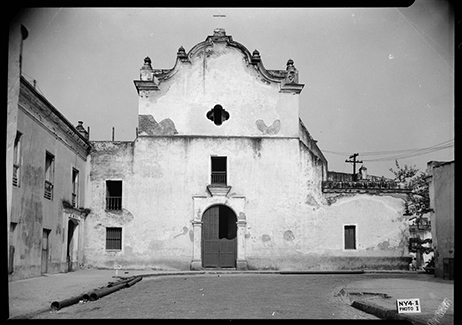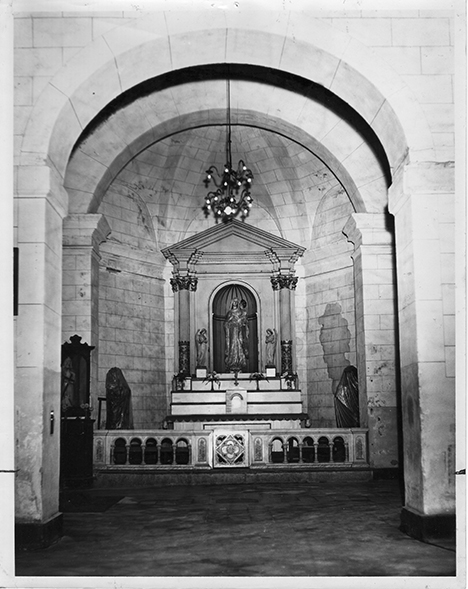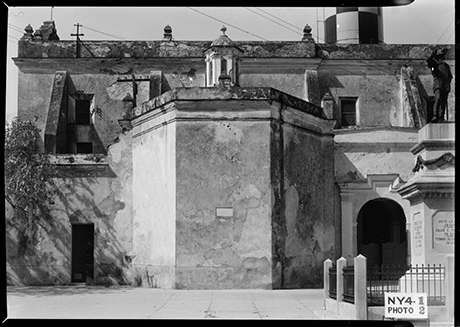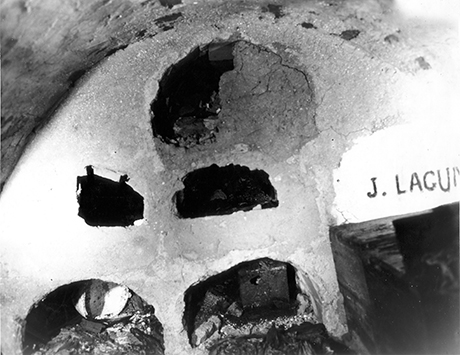Built
in multiple phases beginning in 1523, the convent church of San José
has evolved over time bearing witness to the religious, political, and
cultural life of San Juan, Puerto Rico, and the Caribbean world. While
the church has remained in the hands of the Catholic Archdiocese
throughout its history, stewardship has passed between the Dominican,
Jesuit, and Vincentian orders, each contributing to its complex
history. Of particular architectural significance is the early
Isabelline Gothic ribbed vault construction, which incorporates
tinajones (Spanish ceramic amphora) between the roof vaults of the
sanctuary and transept, an unusual construction technique that dates to
Antiquity and was brought to the New World by Spanish builders. The
surviving 17th century painted interior of the Rosario Chapel has
particular significance due to a past restoration which removed almost
all of the original plasters in the main church, thus making the chapel
a rare survivor.
|
|
|
An
annotated chronology of Iglesia San Jose first mentions the Rosario
Chapel in the 1582 Memoria of Ponce de Leon. The patrons of the chapel
at this time are believed to have been Juan Guilarte and his
sister-in-law Dona Luisa de Vargas who donated funds to the chapel for
use as a family crypt. Between 1635 and 1641, major renovations to
the church occurred with the support of Governor Inigo Mota de
Sarmiento, after the 1625 Dutch attack. These renovations included the
completion of a gabled wooden roof over the incomplete main nave,
reconstruction of the transept, and the remodeling of the free-standing
Rosario Chapel as a “pantheon for the governors of the island”. This
description helps to date the dome construction of the Rosario Chapel
to the mid 17th century. Over 60 people were buried in the crypt
beneath this chapel, many of them early governors of Puerto Rico.
In
1776, four years and two hurricanes later, 4,000 pesos were sent by the
King of Spain for repairs. It is at this time that buttresses are
thought to have been added to help support the newly constructed brick
barrel vault of the main nave. Some of these buttress supports rest on
the lower roofs of the side chapels including the dome of the Rosario
Chapel and clearly post date the construction of the chapel.
The
next significant period in the chapel’s history is one marked by
neglect. Between 1821 and 1824, laws of the exclaustracíon de
religiosos (suppression/secularization of religious orders) were
enforced over the Island’s convents. This required that rent be paid
for rooms in the convent. The rates were too costly, and all but one
monk left the Church convent, leaving the church in a state of
despair.
It was not until 1858 that the church was
transferred to the Jesuit Order, and with their stewardship came the
much needed financial support for repairs, renovations, and
maintenance. It was at this time that the church was dedicated to San
José. An 1858 budget document submitted by José María Pujol, the church
caretaker, included costs for roof repairs and resurfacing treatments
using burnished mortar, replacement of plaster stuccos, application of
lime-washes, the construction of new retablos and furnishings, as well
as the purchase of ornaments. This was the most significant
transformation of the church since its original construction phases.
The work continued on the interior of Iglesia San Jose between 1860 and
1863, this time reflecting mid-century neoclassical tastes. The Jesuit
order administered over the church until 1887 when the Vincention
Fathers assumed the role which they continue to hold today.
|
|
 |
| Iglesia San Jose, west elevation |
|
|

|
 | |
The
church is believed to have had all its plaster surfaces painted with
both geometric as well as floral motifs. However, many of
the aforementioned and later restoration efforts, unfortunately removed
much of the architectural evidence needed to understand the
evolution of the church. Almost all plaster
finishes in the sanctuary, transept and nave were lost to such
interventions while leaving the Rosario Chapel untouched; the Chapel is
thus a unique survivor within the church for its painted surfaces. The
Rosario Chapel murals are therefore the only complete stratigraphic
history of interior finishes in Iglesia San Jose dating back to the
17th century.
The Rosario Chapel has a rich history of
painting. There are as many as twenty layers of plasters and painted
designs that have been applied to the chapel ceiling since the 17th century.
Many of the layers appear to be simple white lime-washes, but
interleafed between them are design campaigns that are either figural
or geometric.
|  | Rosario Chapel exterior view
|
| 
| Crypt of the Capilla Virgen del Rosario
|
|
|
|





